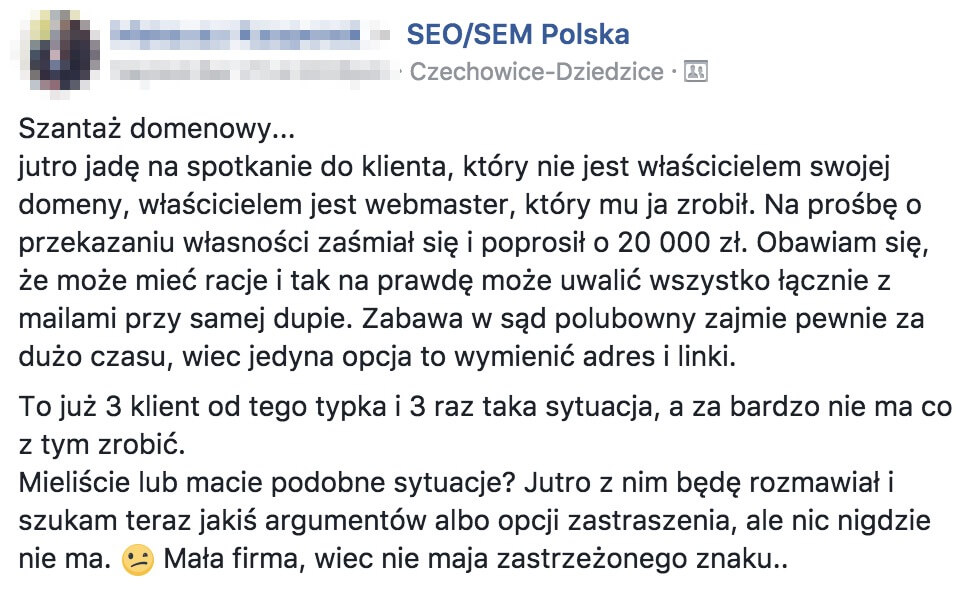
Compendium: What should you know about the Internet domain?
Without a website address, i.e. a domain name, nobody will visit your website. Maybe apart from magicians who know the IP address of the server on which it is located and know how to use it. Anyway, can you imagine visiting the Internet by typing a complicated sequence of numbers to see your favorite service?
I can’t imagine it! Fortunately, someone invented an Internet domain that makes it easier for us. And this is what the compendium will be about. I will try to discuss the most important topics related to domains, mainly the Polish domain.
Spis treści
What is an Internet domain?
Simply put, a domain is a unique name throughout the Internet that identifies a resource on the Internet, a website, an e‑mail address, a server address.
This name consists of a sequence of characters separated by dots, where the top level domain is always located at the very end. For Poland it is .pl. Other countries have their own endings, such as Germany – .de.
What does the Internet domain look like?
The Internet domain name has some limitations (e.g. maximum 63 characters, not counting the .pl extension). It may consist only of letters of the Latin alphabet, digits and the “-” sign. (minus). The “-” sign cannot appear at the beginning, at the end and simultaneously at the 3rd and 4th position in the domain name. The exception is IDN domains.
Types of Internet domains
In Poland, we distinguish between several types of Internet domains. These are:
- country domain .pl
- regional domains e.g.: .waw.pl, .slask.pl
- functional domains e.g.: .com.pl, .org.pl, .biz.pl
- government domains e.g.: .gov.pl, .ic.gov.pl – domains of the government type may only be registered by authorized entities such as public authorities, professional self-government bodies, representing persons performing public trust professions,
- ENUM domains
- IDN domain
ENUM domains
It is a special technological platform that enables the exchange of telephone numbers from the E.164 standard to the Internet domain address. For ENUM, obtaining an IP address (e.g. a server on which there is a WWW server serving a domain) is not crucial, it is first of all about connecting various telecommunication services with a phone number stored in the form of an Internet domain.
For more information, please visit dns.pl/ENUM.
IDN Domains
The IDN (Internationalized Domain Name) is actually a domain with tails. Thanks to this technology, it is possible to register a domain that uses diacritical national characters specific to the language.
W przypadku polskiej domeny internetowej mogą to być znaki typu ś, ć, ą. Dzięki temu możemy zarejestrować domenę typu żółw.pl, a nie zolw.pl. Z technicznego punktu widzenia, domena żółw.pl (postać unikodowa) wygląda jednak tak: xn--w-uga1v8h.pl (postać ASCII), aby sprostać ograniczenim, jakie stawia domena.
In the case of the Polish Internet domain, these may be ś, ć, ą characters. Thanks to this we can register the domain type żółw.pl, not zolw.pl. From the technical point of view, the domain żółw.pl (unique character) looks like this: xn--w-uga1v8h.pl (ASCII form) to meet the limitations of the domain.
Nothing stands in the way of registering the domain черепаха.pl (turtle in Russian). However, please keep in mind one limitation. It is not allowed to mix characters from different language sets, which means that it is impossible to use Cyrillic, Polish petioles and Hebrew letters in the name at the same time.
An interesting fact is that NASK is the first registry in Europe and one of the first in the world to introduce the possibility of registering IDN domains.
How do I choose a name for my domain?
Before registering an Internet domain, it is a good idea to consider its name. Will it be a regional domain, IDN or a foreign domain? Think about it before you make your first purchase.
When we specify our Internet domain name (e.g. company name), let’s think about its “end”. If you run a business in Poland, it is worth considering the .pl domain, but if it is an educational website – then maybe .edu? Nothing stands in the way of buying a few Internet domains, e.g. .edu:
- thecamels.org – company’s main domain
- thecamels.pl – domain directing to the Polish version of the website
- thecamels.eu – domain directing to the English version of the website
We can also think about buying a new name with Polish signs. It will be easier to dictate such an address to someone over the phone than to break your language by removing “tails”.
How to register a domain?
By registering an Internet domain, you become its subscriber, not its owner. As long as we pay it to our registrar, we can use it for as long as we can. Remember to register the domain on yourself or your company, and not on the data of the agency that executes your site, or on the data of a colleague because he knows it in computer science.
How to take care of your domain?
When registering an Internet domain, it is worth remembering a few rules to ensure its security. First of all, make sure that your domain does not expire. For example, you can pay for the .pl domain 10 years in advance. If you forget to pay for the domain, do not panic. It does not disappear immediately and for some time you can still recover it. This is called a quarantine buyout.
Another very important thing is to ensure that your contact details, in particular your e‑mail address, which are stored in the Domain Registry, are up to date. There is nothing worse than registering a domain to an e‑mail address to which we have lost access, or these are the data of e.g. an agency that makes a website for us.

You can always change the current data by contacting your domain registrar. Any information about changes to your domain name is sent to the e‑mail address provided in the Registry.
In case of the .pl domain, you can make sure that your registrar is an official partner of NASK or that it uses the chain of intermediaries. You can always change it easily by using the transfer option.
Your domain can also be protected by the Registry Lock service, which protects against domain theft.
The Camels company is the official registrar of the .pl and .eu domains. We have a partnership with NASK and EURiD.
What is domain transfer?
Domain transfer is a change of the domain registrar, i.e. the company that will support it from the technical side. Domain transfer does not change the domain subscriber.
The main reason for the transfer of domains is the transition to a company that has a clear price list for domain fees. Many companies “tempt with a promotional price” for the first period of domain registration (e.g.: domain for 0 PLN), then the promotional conditions are designed in such a way that in order to use a given domain, we have to pay twice as much for the following years.
It is also worth to transfer the domain to a hosting company, so that everything is paid for in one place. It often happens to clients that after paying for the server, they forget to pay for the domain and their website stops working.
Transferring domain support to another operator is very simple and usually requires the same steps for most domains.
In case of .pl domain the transfer is free of charge and does not change the expiration date of the domain. It is worth remembering that each Domain Registrar has its own procedures, e.g. transfer of global domains is paid, but it extends its validity period by one year.
Other such differences are the dates when such a transfer can be made. For .pl domains it takes 5 days after its registration or transfer in order for the next transfer to take place. In case of global domains like .org, .com – it is 60 days. The .eu European domain has no such restrictions.
What is needed for domain transfer?
To transfer a domain to another registrar, you will need to obtain an Authinfo (sometimes called Authcode or EPP) authentication code from the current registrar.
Each registry shall have its own procedure for obtaining such a code. Some companies require you to complete an application form and send it by post. Exactly the same method is used to send back the code. This is very cumbersome and time-consuming. What’s worse, such a recorder sets the validity time of the AuthInfo code to expire before the mail delivers the letter. Therefore, if you want to transfer the domain from such a registrar, you should be interested in it much earlier and not leave it at the last minute.
Very often dishonest domain registrars hinder the process of Authinfo code release. The most common cases are:
- a claim that the request for a code has not reached the Registrar
- pretending that the codes were sent and that it was Poczta Polska that lost the letters
- delay the release of code so that the domain expires and needs to be renewed by the current registrar
- sending the auhtinfo codes by post and changing them after one day – the codes become invalid
- issuing wrong codes,
- issuing not authinfo codes, but codes for internal assignments at the register,
- requiring a company stamp.
At your request the registrar is obliged to issue an authinfo code immediately. The Registrar cannot make the issuance of the authinfo code subject to additional conditions, including payment of a fee.
dns.pl
Virtually every domain registry has a possibility to obtain a code and report a dishonest registrar in an emergency.
Before obtaining an authorization code, the Registrar must ensure that it is requested by the actual domain subscriber and not by a third party. The authorization code should be given to the new recorder in a secure way, e.g. via the client panel.
How does domain transfer look like?
Domain transfer usually consists of four steps. As an example I will use the .pl domain.
- Obtaining an authorization code. If you meet the conditions of the recorder procedure, the recorder will issue an Authinfo code,
- Transmission of the code to the new recorder, through a secure channel,
- Initialization of the transfer by a new recorder. Initiation of the transfer is possible at the earliest 5 days after the registration of the domain or its last transfer.
- Approval of the transfer by the subscriber.
The last step is the most important! The domain subscriber receives an email from the domain registry with a link to accept the transfer. If the link is not clicked, the transfer will not take place. Therefore, it is important to always have up-to-date data in the domain registry.
After the transfer is confirmed, the .pl domain will be transferred to the new registrar immediately and e.g. in case of global domains it will take up to 10 days.
Domain life cycle
Each Internet domain has its own life cycle from registration to expiration. You can check the current status of your domain in the WHOIS database.

If the domain is not paid for on time, it becomes BLOCKED. For 30 days the subscriber can still recover the domain (buy it out of quarantine for an additional fee). After this time the domain will be returned to free domains and everyone will be able to buy it.
For example, a domain in BLOCKED status can be moved to another recorder, but the DNS delegation can no longer be performed.
What is WHOIS?
Each Domain Registry maintains a database that contains information about the domain. Such data are e.g.: on which DNS servers the domain is located, when it was registered and when it expires, who is its registrar or subscriber.
Some domain registries offer domain privacy protection so that subscriber data is not available to the public. The WHOIS database is available for the .pl domain:
- at http://www.dns.pl/whois
- on the WHOIS service server running on whois.dns.pl (port 43), which can be used using standard tools, e.g. whois, jwhois.
Fragment of the result from WHOIS database for the domain thecamels.pl.
whois: whois.dns.pl
status: ACTIVE
remarks: Registration information: http://www.dns.pl/english/
created: 1990-07-30
changed: 2018-09-07
source: IANA
DOMAIN NAME: thecamels.pl
registrant type: individual
nameservers: dns1.thecamels.org.
dns2.thecamels.org.
created: 2010.12.02 15:05:36
last modified: 2018.12.15 23:57:35
renewal date: 2019.12.02 15:05:36
no option
dnssec: Unsigned
REGISTRAR:
The Camels s.c.
Wróblewskiego 18
93-578 Łódź
Polska/Poland
+48.530887799
info@thecamels.org What is a domain option?
Each Domain Registry can offer different functions for its domains, such as: Registry Lock or domain option. So what is the option?
This is the priority for domain registration after its release by the current subscriber. Buying a domain option gives you the guarantee that you will be the first to be able to buy a domain, provided that the current subscriber does not renew it.
The domain option is useful when you plan to make sure that no one else will buy a domain that has probably been abandoned by the subscriber.
Only one option can be purchased for a given domain. The option for a domain is valid for 3 years.
Verification of e‑mail address for global domains
Global domains (e.g. .com, .org, .biz) require additional confirmation of the e‑mail address after performing specific operations on the domain. This requirement appeared on 1 January 2014 and consists in clicking on the link sent to the subscriber’s e‑mail. The message is sent after:
- domain registration,
- transfer the domain to another operator,
- changing the subscriber’s data.
Fortunately, you don’t have to verify this e‑mail address every time. It is sent only once for verification purposes. Subsequent domain registrations and transfers using the same e‑mail do not require verification.
If the e‑mail address is not confirmed within 15 days from the date of the operation, the domain will be blocked. As soon as the subscriber clicks on the link, the domain will be unlocked.
Check other blog posts
See all blog posts
6 April 2022
Why is it a good idea to split sites across different hosting accounts?
Read moreMultiple websites on one server is a threat that can have different faces. Find out what the most important ones are and see why you should split your sites on different hosting accounts. Powiązane wpisy: Compendium: how to secure your WordPress? Everything you have to keep in mind when creating an online store Useful plugins…

13 September 2021
How do you get your website ready for Black Friday or more traffic?
Read moreToo much website traffic can be as disastrous as no traffic at all. A traffic disaster results in server overload. In such a situation, no one is able to use e.g. your online store’s offer, and you do not earn. Learn how to optimally prepare your website for increased traffic. Powiązane wpisy: Compendium: how to…

10 September 2021
Password management or how not to lose your data
Read moreDo you have a bank account? Use the internet with your smartphone? Congratulations! Then you are on the brighter side of the power, where digital exclusion does not reach. But can you take care of the security of your data as effectively as you invite your friend for a beer via instant messenger? Powiązane wpisy:…
